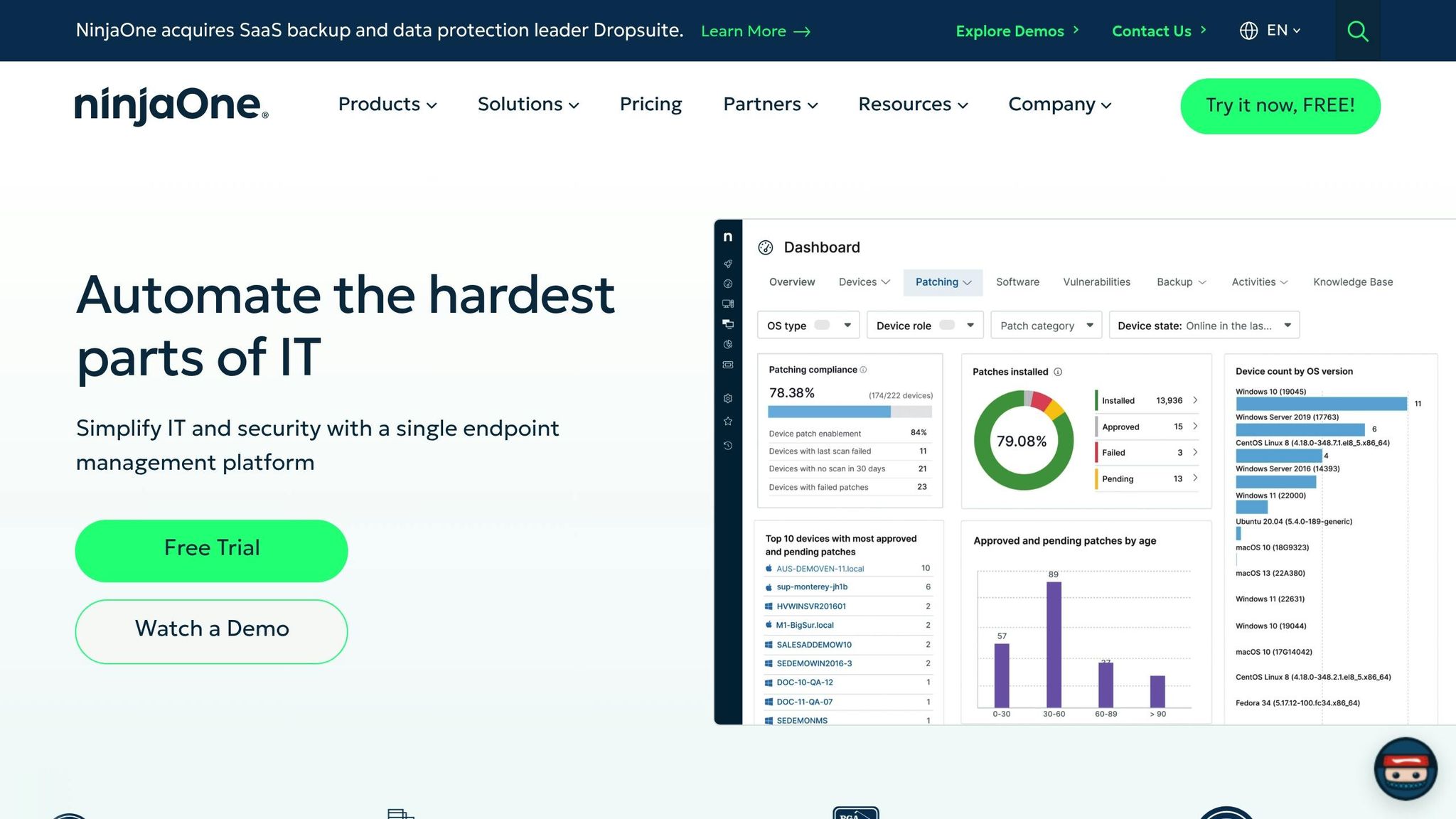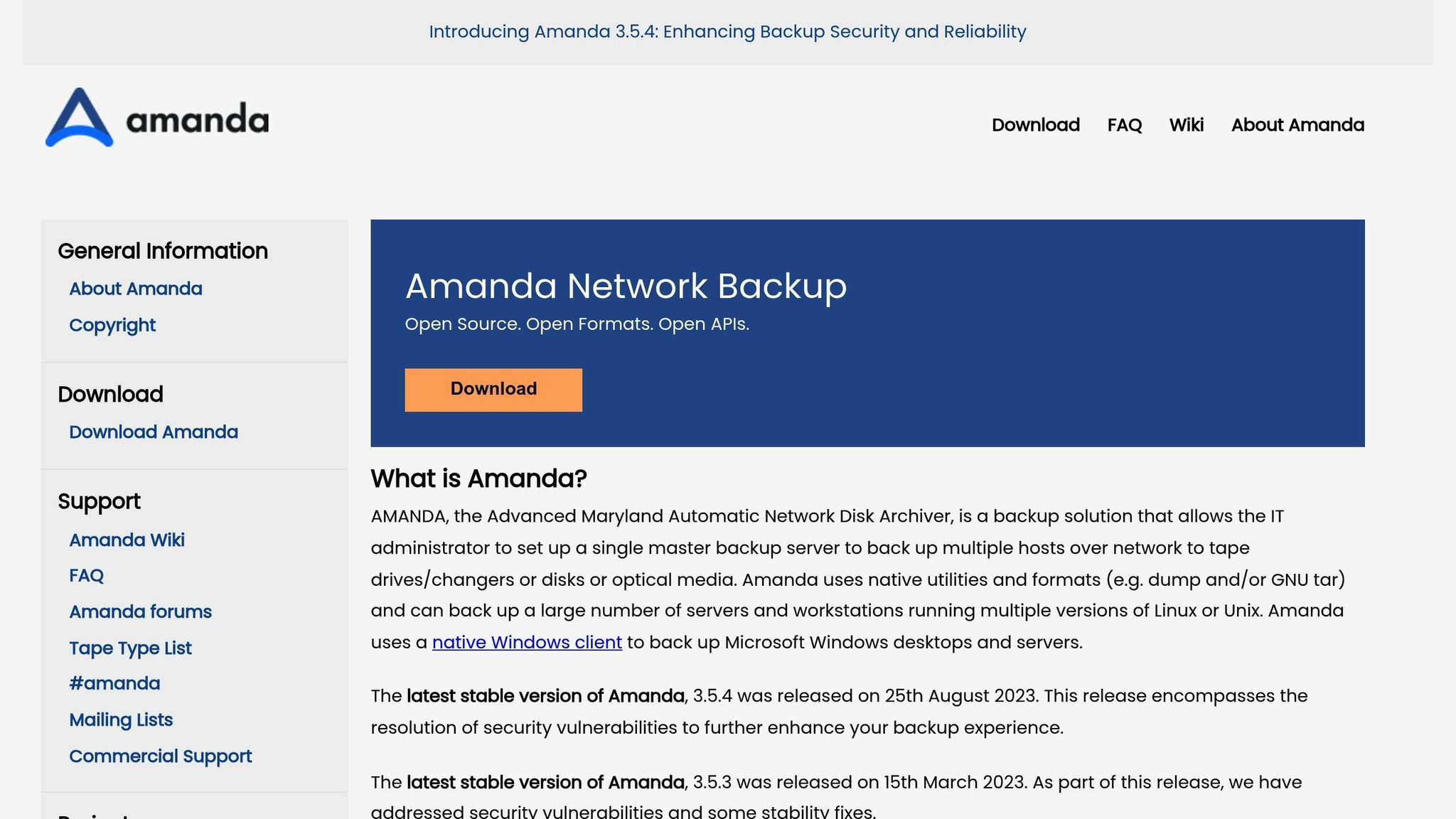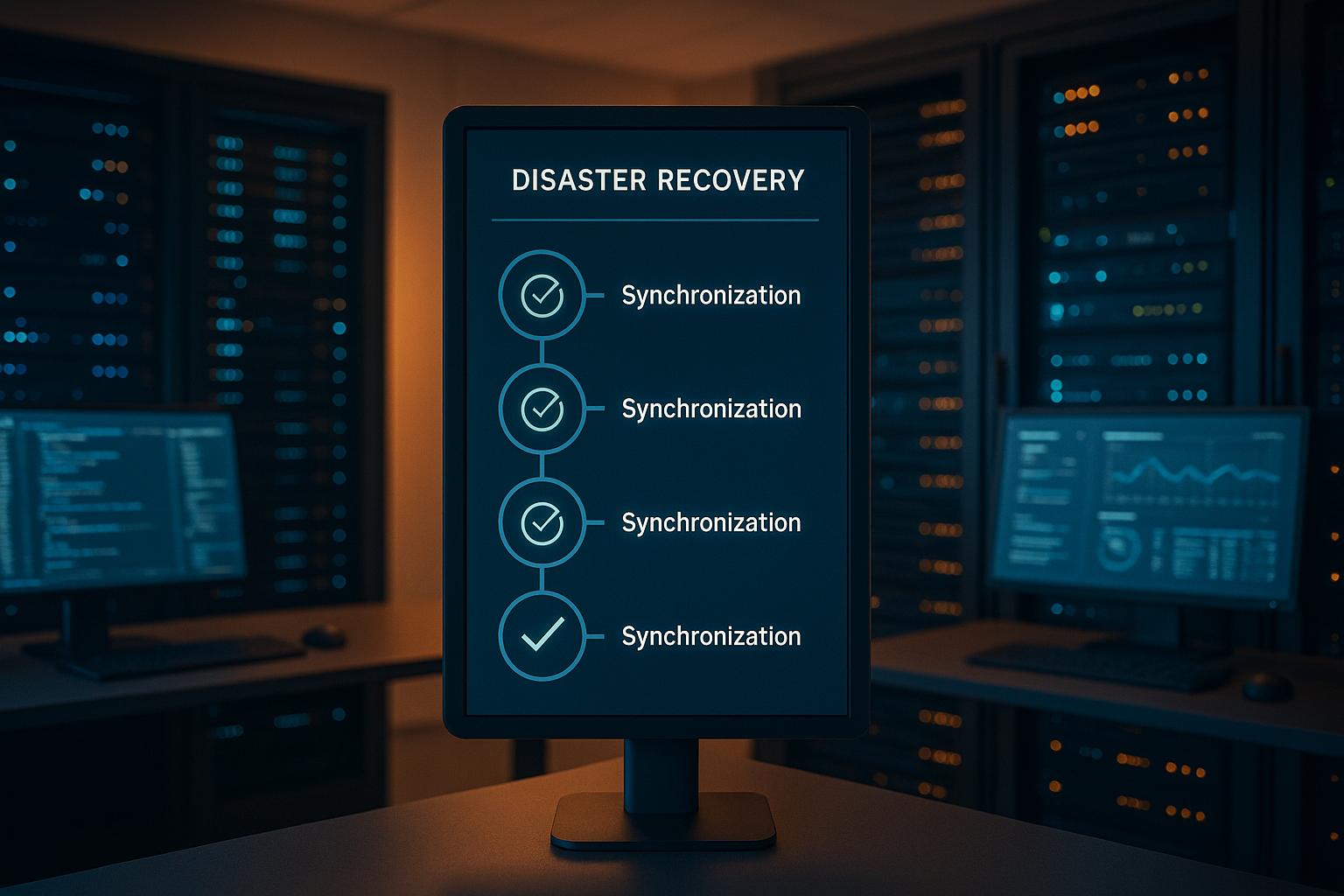The right automated disaster recovery (DR) validation tools can save your business from downtime, data loss, and compliance headaches. Here's what you need to know:
- Why It Matters: Regular DR validation ensures your systems can recover quickly during disruptions, avoiding revenue loss, operational delays, and reputational harm. In 2022, disruptions cost US businesses an average of 15% of their revenue.
- Benefits of Automation: Automated tools reduce human error, speed up testing, and provide consistent results. They’re essential for cloud and hybrid systems that are too complex to test manually.
- Key Features:
- Automation: Tools with failover capabilities and pre-configured recovery processes.
- Integration: Compatibility with multi-cloud setups and existing infrastructure.
- Compliance: Detailed reporting to meet legal and regulatory requirements.
- Top Tools:
- Commvault: AI-driven automation with features like cleanroom recovery.
- Firefly: Ideal for multi-cloud environments.
- NinjaOne: Policy-driven automation for endpoint recovery.
- N-able Cove: Focused on hosting providers and multi-tenant management.
- Open Source: Amanda, Bacula, and Duplicity for customisable, cost-effective options.
Quick Comparison
| Tool | Best For | Key Features |
|---|---|---|
| Commvault | AI-driven recovery | Continuous replication, cleanroom recovery |
| Firefly | Multi-cloud setups | Cross-cloud monitoring, resource management |
| NinjaOne | Endpoint recovery | Policy-driven backups, easy integration |
| N-able Cove | Hosting providers | Automated testing, multi-tenant management |
| Open Source | Custom setups | Flexible but requires technical expertise |
Using Infrastructure as Code (IaC) tools like Terraform and Ansible can further streamline DR validation, ensuring consistent recovery processes and reducing errors by up to 50%. Start small, test configurations in isolated environments, and use version control for better management.
Choosing the right tool depends on your organisation's needs, compliance requirements, and technical capabilities. If you're unsure, consulting experts like Hokstad Consulting can help optimise your approach.
Demo - Reduce Risk & Recovery time with Commvault (Automation) Part 1
Features to Consider in Automated DR Validation Tools
When selecting an automated disaster recovery (DR) validation tool for complex managed hosting environments, it’s important to focus on features that enhance reliability and efficiency.
Automation and Orchestration Features
At the heart of any robust DR validation tool are automated failover capabilities. These ensure systems can seamlessly switch to backup environments when primary systems go offline, reducing downtime and minimising the need for manual intervention during critical situations [1]. The most effective tools include pre-configured failover processes with detailed runbooks or scripts that outline the recovery sequence step by step.
Look for tools that consolidate recovery applications, resources, and configurations into predefined dependencies. In cloud-based environments, orchestration platforms simplify recovery protocols by automating failure procedures, and some even incorporate AI-driven features to help reduce the risk of human error during high-pressure scenarios.
Top-tier solutions offer comprehensive automation and orchestration capabilities, enabling smooth integration with your existing infrastructure and laying the groundwork for efficient disaster recovery processes.
Integration and Compatibility
The ability of a DR validation tool to integrate seamlessly with your existing managed hosting environment is crucial. Prioritise tools designed to work with remote access, high availability, and redundancy. Additionally, support for multi-cloud setups is essential to avoid being locked into a single vendor [1].
Strong compatibility not only protects your current infrastructure investments but also enhances resilience. Cloud-based DR solutions are particularly cost-efficient, as they eliminate the need for a secondary data centre. Instead, organisations pay only for the minimal resources required to maintain recovery readiness. Effective integration also enables faster recovery through continuous or near-real-time replication.
When assessing DR solutions, ensure they can support all critical workloads, integrate with third-party management platforms or native APIs for automated backups and recovery, and provide intuitive dashboards with clear reporting. These features improve oversight and streamline recovery processes.
Compliance and Reporting Features
Compliance is a key consideration when choosing a DR validation tool. Many regulatory frameworks require businesses to meet specific Recovery Time Objectives (RTO) and Recovery Point Objectives (RPO). Therefore, it’s essential to select a tool that can generate detailed documentation to prove adherence to legal and industry standards. Comprehensive reporting capabilities also provide valuable audit evidence.
Tools aligned with compliance frameworks offer validated systems of controls and detailed logging. For organisations operating in regulated sectors, it’s critical that the DR solution supports risk management, standardised incident reporting, and annual testing programmes.
A well-structured disaster recovery plan, built around industry standards, ensures that operations can be restored quickly after disruptions. Look for solutions that include regular backup cycles with secure offsite storage and generate detailed test reports. These features not only reduce stress during audits but also help safeguard sensitive data by providing clear documentation of all recovery actions.
Best Tools for Automated Disaster Recovery Validation
When it comes to automated disaster recovery (DR) validation, there’s a variety of tools available, each tailored to meet different hosting and operational needs. Here's a closer look at some of the most effective options.
Commvault Disaster Recovery
Commvault stands out with its use of AI-driven automation to ensure validated data is restored quickly and securely. This system is designed to minimise risks by detecting and preventing corruption or malicious code during recovery processes [2].
It offers two recovery modes: Operational Recovery and Autonomous Recovery, both aimed at reducing downtime through continuous replication and automated failover mechanisms [4]. Additional features like Cloudburst recovery and cleanroom recovery add extra layers of security during validation. The platform also supports forensic analysis, enabling teams to investigate potential security incidents while keeping systems operational.
Real-world examples highlight how organisations have achieved faster recovery times and improved security using Commvault [2].
Firefly

For businesses operating across multiple cloud environments, Firefly is a strong contender. It specialises in multi-cloud monitoring and resource management, ensuring that failover resources are always properly configured. Its ability to manage resources across various cloud providers makes it a valuable tool for organisations with complex, multi-cloud setups.
NinjaOne Backup and Disaster Recovery

NinjaOne is designed with policy-driven automation at its core, offering automated backups and granular recovery options for a wide range of endpoints [3].
It integrates smoothly with endpoint management systems, providing a centralised view of backup statuses across all managed devices. This ensures consistent protection, regardless of the operating system in use.
N-able Cove Data Protection

N-able Cove is tailored for hosting providers, focusing on automated recovery testing and rapid failover. Its multi-tenant management capabilities allow hosting companies to oversee disaster recovery validation for multiple clients from a single interface.
One of its key strengths is automated recovery testing, which validates recovery processes without disrupting live systems. This is particularly beneficial for hosting providers needing to demonstrate their recovery capabilities to clients while maintaining service level agreements.
Open Source Options: Amanda, Bacula, and Duplicity

For organisations with strong technical teams, open-source tools like Amanda, Bacula, and Duplicity provide flexible and cost-effective alternatives to proprietary solutions:
- Amanda delivers reliable core functionality but lacks the polished interface and commercial support of enterprise-grade tools [5].
- Bacula offers extensive customisation, strong security features, and scalability, though it comes with a steeper learning curve [5].
- Duplicity focuses on encrypted, incremental backups via a command-line interface, making it a favourite among developers needing robust GPG encryption [5].
While these tools offer complete control over backup and recovery processes, they require significant technical expertise. They may also lack built-in compliance features, which could be a limitation for organisations in regulated industries [6].
Choosing the Right Tool
The decision between commercial and open-source solutions often comes down to factors like available technical resources, compliance needs, and budget. Commercial tools typically offer faster deployment and dedicated support, while open-source options provide more room for customisation and control.
These tools lay the groundwork for integrating disaster recovery validation with Infrastructure as Code, pushing efficiency even further.
Need help optimizing your cloud costs?
Get expert advice on how to reduce your cloud expenses without sacrificing performance.
Using Infrastructure as Code for DR Validation
Infrastructure as Code (IaC) allows you to define your disaster recovery (DR) environment using code, ensuring predictable and consistent recovery processes. This approach eliminates the guesswork that often jeopardises recovery efforts.
When paired with tools like Terraform and Ansible, IaC becomes a powerful ally in DR validation. Terraform takes care of provisioning the infrastructure required for DR environments, while Ansible handles configuration and application deployment during recovery. Together, they ensure that both your infrastructure and applications are restored exactly as intended. This combination enables more reliable and automated recovery workflows.
For instance, a digital payment platform transitioned from manual setups to Terraform-driven automation, processing over 10 million transactions monthly. This shift not only improved their resilience but also allowed better cost control, showcasing the practical advantages of IaC in DR validation [7].
Benefits of IaC in DR Validation
Using IaC brings measurable benefits to organisations. Reports indicate a 50% reduction in configuration errors and a 60% decrease in deployment failures [8]. Additionally, businesses adopting IaC can achieve operational cost savings of up to 30% annually [8].
One of IaC’s standout benefits is its repeatability. Traditional disaster recovery often struggles due to inconsistencies between production and recovery environments. IaC eliminates this issue by using the same code to define both environments, guaranteeing identical configurations every time.
For organisations with complex setups - whether multi-cloud or hybrid hosting - IaC ensures consistency across environments. Whether recovering to AWS, Azure, or on-premises infrastructure, IaC definitions maintain uniformity in network configurations, security groups, and application dependencies. This approach also prevents environment drift, thanks to well-documented code [9].
IaC Integration Best Practices
To maximise the effectiveness of IaC in DR validation, it’s essential to follow best practices that enhance reliability and efficiency.
Version Control: Use systems like Git to manage all configuration files. This practice allows you to track changes, roll back problematic updates, and maintain a clear audit trail of your DR infrastructure’s evolution [7].
Testing Configurations: Always test IaC configurations in a sandbox or isolated environment before deploying them in live scenarios. This step reduces the risk of failures during actual disasters [7].
| Best Practice | Tool | Purpose |
|---|---|---|
| Automate Deployment | Terraform / CloudFormation | Reduce manual effort |
| Detect Drift | AWS Config / Terraform Plan | Ensure state accuracy |
| Secure Secrets | Vault / AWS Secrets Manager | Protect sensitive information |
Monitoring for Drift: Tools like Terraform’s Drift Detection or AWS Config help ensure that your deployed environment matches your defined codebase, preventing unexpected discrepancies [7].
Security Integration: Adopt least-privilege access policies and secure sensitive data, such as API keys and database passwords, using secret management tools like Vault or AWS Secrets Manager [7].
Modular Design: Break down IaC code into reusable modules that can be applied across various environments and recovery scenarios. This approach reduces duplication and promotes consistent configurations [7].
Incremental Implementation: Start small by automating straightforward components before tackling more complex systems. Declarative definition files allow you to specify the desired setup without detailing every step, while idempotency ensures deployments always yield the same results [7][9].
For organisations using managed hosting environments, aligning IaC practices with DR validation strategies not only improves recovery reliability but also enhances operational efficiency. If you’re looking for expert guidance, Hokstad Consulting offers strategic insights and tailored support to help you optimise your approach (https://hokstadconsulting.com).
Conclusion and Takeaways
In today’s managed hosting environments, automated disaster recovery (DR) validation is no longer a luxury - it’s a necessity. With the global average cost of a data breach projected to hit £3.9 million in 2024 - a 10% rise from 2023 - businesses simply can’t afford to rely on manual processes to manage such risks [12].
The tools discussed in this guide offer a range of features tailored to different needs. Whether you go for enterprise-grade solutions like Commvault or budget-friendly options like NinjaOne, the key is finding a tool that fits seamlessly into your existing systems while delivering the automation needed to ensure reliable recovery validation.
Choosing the Right Tool for Your Business
Selecting the right automated DR validation tool begins with understanding your organisation’s unique needs. Conducting a Business Impact Analysis (BIA) is a great starting point. This helps identify critical processes, estimate the impact of downtime, and determine your Recovery Time Objective (RTO) and Recovery Point Objective (RPO). Beyond that, you’ll need to factor in compliance requirements such as continuous monitoring, audit management, risk management tools, and automated alerts [11].
| DR Strategy | Upfront Cost | Recovery Time | Best For |
|---|---|---|---|
| Cold Site | Medium | Hours to days | Budget-conscious organisations |
| Warm Site | High | Minutes to hours | Balanced approach |
| Hot Site | Very High | Seconds to minutes | Mission-critical operations |
| DRaaS | Low | Minutes | High uptime without infrastructure investment |
Your current tech stack also plays a critical role. For organisations using Infrastructure as Code, it’s essential to choose tools that integrate smoothly with these platforms. If you’re operating in a multi-cloud environment, look for solutions that can manage the complexity of multiple providers while maintaining consistency across them.
Another crucial aspect is regular testing. This includes setting clear objectives, creating detailed test plans, engaging stakeholders, and analysing test results to identify and address any weaknesses [10]. If your team lacks the necessary expertise, bringing in professional help can make all the difference.
Getting Expert Help
Automating DR validation can be particularly challenging in complex or highly regulated environments. Integration and configuration often require a level of expertise that may not exist in-house.
That’s where Hokstad Consulting comes in. They offer tailored solutions to help businesses optimise their disaster recovery validation processes. With expertise in DevOps transformation, cloud infrastructure optimisation, and custom automation, their team is well-equipped to guide you through implementation while ensuring cost-effective outcomes.
For organisations managing hybrid or multi-cloud setups, professional guidance is invaluable. Experts can help you avoid common mistakes, speed up implementation, and align your DR strategy with your broader business goals. By reducing downtime, improving efficiency, and cutting cloud costs, Hokstad Consulting ensures your organisation is prepared for whatever comes its way - all while maximising the reliability of your recovery processes.
FAQs
How do automated disaster recovery validation tools help ensure compliance with legal and regulatory standards?
Automated disaster recovery validation tools are essential for helping organisations meet legal and regulatory requirements. They streamline the creation of clear, auditable records of recovery processes, making compliance much easier to manage.
By automating tasks like documentation, reporting, and real-time monitoring, these tools ensure that industry regulations are consistently followed. They also provide detailed insights into recovery operations, enhancing transparency and making it easier to demonstrate compliance during audits. The result? Reduced risks of non-compliance, stronger data security, and improved operational reliability - key priorities for any regulated environment.
What should you consider when using Infrastructure as Code for disaster recovery validation?
When incorporating Infrastructure as Code (IaC) into disaster recovery (DR) validation, the key lies in prioritising automation, rigorous testing, and building resilience. Use scripts to automate recovery processes, ensuring that restoration is both quick and consistent. Regularly test these scripts in controlled disaster recovery scenarios to confirm they perform as expected.
Set clear recovery goals, such as Recovery Time Objectives (RTO) and Recovery Point Objectives (RPO), and integrate failover mechanisms directly into your IaC scripts. Make it a routine to validate your infrastructure's ability to be rebuilt from the ground up, guaranteeing that your systems are always ready to handle the unexpected. This proactive strategy strengthens operational reliability and reduces downtime during critical situations.
What are the key differences between open-source and commercial disaster recovery tools in terms of flexibility and support?
Open-source disaster recovery tools stand out for their customisability and scalability, enabling organisations to tailor them to meet specific needs. This flexibility can be a significant advantage, especially for businesses with unique setups or requirements. However, these tools often lack the dedicated support that comes with commercial solutions, which can be crucial when quick troubleshooting or a fast response is needed during emergencies.
On the other hand, commercial tools, including Disaster Recovery as a Service (DRaaS) options, are known for offering strong support and service guarantees. This makes them a dependable choice in high-pressure situations. That said, they are often designed for general use cases, which may limit their ability to adapt to highly specific configurations.
Essentially, open-source tools excel in customisation, while commercial solutions prioritise reliability and support.
